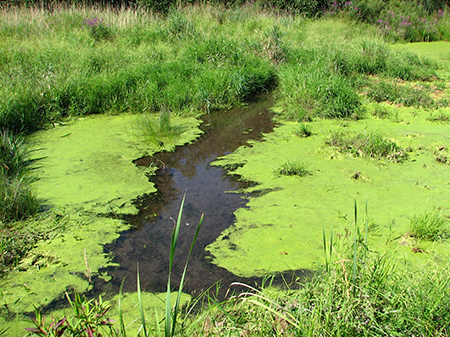In August, blue-green algae made headlines across the United States following a series of dog deaths. In each tragic case, the pup had played in a body of body water – usually a lake or pond – and experienced extreme symptoms such as seizures and organ failure shortly after. By the time the owners arrived to the vet, most of the dogs had already passed on.
The blue-green algae epidemic seemed to peak in the Southeastern U.S., but cases occurred as far north as New York and Minnesota, and as far west as Colorado. In Austin alone, blue-green algae in Lady Bird Lake resulted in the deaths of at least five dogs.
Understandably, these news headlines have left pet owners with many questions. What is blue-green algae, why is it so dangerous, and most importantly, how can they keep their dogs safe?
What is Blue-Green Algae?
“Blue-green algae” is a bit of a misnomer; it’s actually not a true algae at all, but rather a type of bacteria called cyanobacteria. It thrives in water and moist soil environments, especially during warm, sunny weather. This may include lakes, ponds, rivers, and even backyard pools and decorative ponds. Scientists have observed cyanobacteria in all 50 states over the years.
Blue-green algae tends to be more prevalent during summer and early fall, when the weather is warmest. Officials in Texas and other affected states had previously predicted that the algae blooms would clear by mid-October.

But as of October 16th, officials in Austin say that Lady Bird Lake and surrounding bodies of water are still contaminated. As such, pet owners should keep their pets away from these bodies of water until officials announce the “all clear”.
In order for this to happen, there needs to be a shift to consistently cool temperatures (below 75 degrees) and increased water flow. Scientists are also looking ahead to summer 2020, and preparing to handle the potential of more blue-green algae blooms.
Why is Blue-Green Algae Dangerous?
Cyanobacteria is incredibly toxic to pets, wildlife and even humans. This is because it feeds off sunlight to produce its own energy, and may release neurotoxins as a byproduct. These toxins can be fatal within just minutes of exposure.
Fortunately, most humans know to state out of scummy, foul-smelling water, which is why you don’t often hear about it affecting humans. But playful pups will happily swim in – and consume – contaminated water. Dogs have even been known to eat dried clumps of algae on the shore.
How Can I Spot Blue-Green Algae?
You may be able to identify bodies of water containing blue-green algae by looking for water discoloration and foam on the surface. In some cases, cyanobacteria may even look like a shimmering substance on top of the water, easily mistaken for paint or oil.
Blue-green algae may also have a foul stench, much like the smell of rotting plants. Unfortunately, these tell-tale signs are not always apparent. Cyanobacteria can lurk on the bottom of the lake, or in small patches that are easy to miss.
What Are the Symptoms of Blue-Green Algae Exposure?
If a dog has come into contact with blue-green algae, they will usually begin showing signs within 15-20 minutes. However, in some cases, it may take hours or days for symptoms to arise.
Signs that a dog has been exposed to cyanobacteria may include:
Unfortunately, due to the extreme toxicity of blue-green algae, ingestion will almost always result in death. That said, you should still immediately bring your dog to the vet if you notice any of these symptoms and suspect blue-green algae contamination.
How Can I Keep My Dogs Safe From Blue-Green Algae?
When it comes to protecting your pets from blue-green algae, prevention is key. There is no known cure, so if a dog has been infected with a high enough dose of the toxin, there is usually nothing that can be done.
You can keep your pup safe by keeping them leashed around bodies of water, especially if it appears dirty or foamy. Never allow your pet to drink from ponds, lakes or other stagnant bodies of water.
If you believe your pet may have come into contact with blue-green algae, immediately wash them with clean water and soap. Be sure to wear gloves to protect yourself! Then, bring them in to see your vet as soon as possible for a thorough evaluation.
Pet owners who live in areas with known blue-green algae blooms should stay especially vigilant. Keep an eye out for signage, and look for updates from the public health department to see if your area has been cleared before letting your pets near any bodies of water.
Environmental scientists say that although blue-green algae blooms have historically been quite rare, they are becoming more common as a result of increasing global temperatures, as well as the use of crop fertilizers.
As the weather continues to cool, experts hope that the current outbreaks will begin to subside. However, pet owners should remain aware of this threat once the weather begins to warm up again in spring, and continue taking all measures to keep their dogs safe.